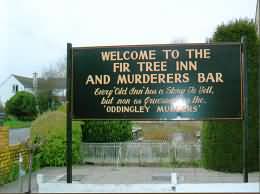 |
| The Local Time is Saturday, 27-Jul-2024 07:42:00 CEST |
Droitwich
Spa Tourist |
|
| YOU ARE HERE: Main Home Page > Worcestershire > Droitwich Spa | E-mail This Page |
|
|
|
|
|
|
|
|
Droitwich Spa, In and AroundDroitwich Spa is situated 6.5 Miles north east of Worcester astride the A38 road. This one time small town has many places of interest, with ample and convenient parking and its attractions have popular appeal. There is much evidence of its historic past, old waterways used for the transportation of salt , spa water pumping stations can all be seen within the town. |
||||||||||||||||||||||||||||||||||||||||||||||||||||||||
 |
||||||||||||||||||||||||||||||||||||||||||||||||||||||||
| Droitwich was known in Roman times as Salinae and salt was extracted by them, however the origins of salt extraction in the area go back to prehistoric times, the brine is 10 times stronger than seawater and can only be compared with that in the dead sea. It was not until the early 19th century that the benefits of
flotation in brine were fully An ideal starting point for visitors is the Heritage Centre in Victoria Square, this centre houses a small but very interesting museum which includes items from the Roman past, the history of salt and of more recent times its connection with radio broadcasting with a display of equipment used. The original Brine Baths have long since closed, but a new brine bath (part of the Droitwich Spa private hospital) opened to the public for relaxation and hydrotherapy. But this too is now closed for financial reasons (December 2008). No date is yet known for it to reopen. The Raven Hotel has a considerable historical past, this
ancient building (much of it timber A little further along St. Andrews Street is St. Andrews
Church, built of stone in the Norman It is interesting to examine the south aisle arch, here The Font is of the Jacobean period and at one time was situated in St. Richards chapel later to be moved to the sanctuary and then on to its present position. Hanbury Hall This stately home can be reached by taking the B4090
and following the signposts, the hall is The Jinney Ring Craft Centre, Hanbury,
signposted off the B4090 This is a collection of 200 year old barns which have been
tastefully converted into 12 craft studios , a restaurant , craft
gallery and gift shop all set in beautiful landscaped gardens, they
were established in 1980 and have been a popular attraction to visitors
ever since. John Corbett has a lasting memorial in the area, it was he who built the Chateau Impney as a home for his French wife, it is said that on its completion that she refused to live there. The Chateau is now a hotel and stands beside the A38 just a mile
from Droitwich town, its The chateau was built in 1875 and 3000 men were employed in its construction which included landscaping of the grounds to include waterfalls, fountains and tropical gardens. Travelling further on the A38 towards Bromsgrove to Wychbold it is possible for visitors to spend many hours at Webbs of Wychbold with its 50 acres of gardening , leisure and pleasure. It has a large amount of gardening requisites on sale besides a gift shop and a restaurant, Webbs have been trading since the middle of the 19th century , the business was founded by Edward Webb who was then an agricultural seedsman trading from Wordsley Nr.Stourbridge, Webbs were appointed seedsmen to Queen Victoria and have been to every Monarch since. Avoncroft Museum of Historic Buildings - Stoke Heath,
Bromsgrove. The open air museum opened in 1967 and has historic buildings
spannng over
700 years. Church of the Sacred Heart and St. Catherine of Alexandria This beautiful church can be reached by taking the A38 from Droitwich
towards Worcester For those who appreciate fine art or the tranquillity of the surroundings, this church is well worth a visit. The Oddingley Murders Continuing towards Worcester on the A38 some 3 miles from Droitwich
the village of Oddingley and the hamlet of Dunhamstead are signposted
near the public house Cop Cut Elm at Martin Hussingtree and
by following this road Oddingley can be reached. There is very little of the village, just a few scattered houses and the church of St. James, however, this small community was very much in the news in 1806 when the peace was shattered by the murder of the Rector, the Reverend G. Parker, known as a hard and an uncompromising man he was a stickler for rules and extracted every morsel when collecting tithes. His murderer was a Richard Hemming a carpenter of Droitwich who was hired by three local farmers, Clewes, Banks and Barnett and a farrier named James Taylor to do the deed. The rector was shot whilst he was driving a herd of cows down a lane, Hemming had hidden in the hedgerow and fired the fatal shot from that position, he immediately fled the scene and was never seen alive again, an extensive search was made and it was assumed that he had escaped from the country. In 1830 during the building of a barn at Netherwood farm, human remains were found and were identified as being those of Richard Hemming. The identification was made by finding a carpenters rule in the mans pocket and it transpired that on the night of the murder Hemming was enticed out of his hiding place in the barn by the promise of food by his employers for the deed done, whereupon Clewes, Banks, Barnett and Taylor set on him clubbing him to death. This was done in order that he could not implicate them in the murder of the Rector. Following the discovery of the body an inquest was held at the Talbot Inn, Barbourne Worcester. By this time Taylor himself had died and the others could not be charged because the principal was dead so they were found to be not guilty. Upon their return to the village the church bells were rung and there was much rejoicing. On the border of Oddingley is the hamlet of Dunhamstead, it was at the local pub The Fir Tree Inn that Thomas Clewes became landlord and hence the reason for the naming of the bar The Murderers Bar. In here is a display of prints and newspaper cuttings that describe the events of the time. The pub has a restaurant and also serve food. |
||||||||||||||||||||||||||||||||||||||||||||||||||||||||
|
||||||||||||||||||||||||||||||||||||||||||||||||||||||||
|
||||||||||||||||||||||||||||||||||||||||||||||||||||||||
| BACK TO TOP | ||||||||||||||||||||||||||||||||||||||||||||||||||||||||
Droitwich Tourist Information Guide |
||||||||||||||||||||||||||||||||||||||||||||||||||||||||
| This page last modified Thursday, 11-Feb-2021 13:25:37 CET | ||||||||||||||||||||||||||||||||||||||||||||||||||||||||

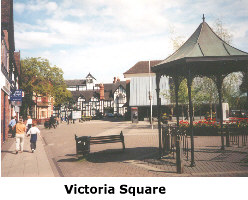 appreciated and brine baths built
, John Corbett turned Droitwich into a fashionable spa, he was
a salt king and a member of parliament and promoted Droitwich as
a health resort.
appreciated and brine baths built
, John Corbett turned Droitwich into a fashionable spa, he was
a salt king and a member of parliament and promoted Droitwich as
a health resort.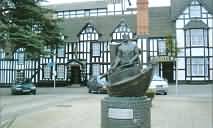 framed) is in St. Andrews
Street and was built during the reign of Elizabeth I, however
the central part of the building is much older and was once
known as the Manor of Wyche. It was the birthplace of St.
Richard de Wyche in 1197, saint and bishop of Chichester,
he was a friend of the homeless and adopted as patron saint of the
Guild of Coachmen of Milan - presumably because he drove
carts on his family farm. He was canonized by Urban
IV in a Franciscan church at Viterbo in 1262, he died at the age
of 56 in Dover and his celebrated feast day is the 3rd of April.
framed) is in St. Andrews
Street and was built during the reign of Elizabeth I, however
the central part of the building is much older and was once
known as the Manor of Wyche. It was the birthplace of St.
Richard de Wyche in 1197, saint and bishop of Chichester,
he was a friend of the homeless and adopted as patron saint of the
Guild of Coachmen of Milan - presumably because he drove
carts on his family farm. He was canonized by Urban
IV in a Franciscan church at Viterbo in 1262, he died at the age
of 56 in Dover and his celebrated feast day is the 3rd of April.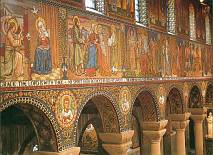 and early English and
decorated styles. In 1928 its bell tower had to be removed because
of subsidence making it unsafe. Amongst many interesting parts
of the church is the chapel dedicated to St. Richard, here the
old bells can be seen and with the exception of 2 are inscribed
- it was said that at one time his relics were contained here.
and early English and
decorated styles. In 1928 its bell tower had to be removed because
of subsidence making it unsafe. Amongst many interesting parts
of the church is the chapel dedicated to St. Richard, here the
old bells can be seen and with the exception of 2 are inscribed
- it was said that at one time his relics were contained here. visitors
will observe that this is supported on the south side of the arch
by a crowned head, shoulders and arms of Henry III and on the other
side there is speculation of who this represents, is it a female
head or an ecclesiastic? perhaps the then Bishop of Worcester.
visitors
will observe that this is supported on the south side of the arch
by a crowned head, shoulders and arms of Henry III and on the other
side there is speculation of who this represents, is it a female
head or an ecclesiastic? perhaps the then Bishop of Worcester. There are many monuments to be seen, of these the most
imposing is the one erected on the south pier of the chancel
to the memory of Captain Coningsby Norbury R.N., who was
with Admiral Benbow in the West Indies and was an envoy from
King George I to the court of Morocco - he died in 1734.
There are many monuments to be seen, of these the most
imposing is the one erected on the south pier of the chancel
to the memory of Captain Coningsby Norbury R.N., who was
with Admiral Benbow in the West Indies and was an envoy from
King George I to the court of Morocco - he died in 1734. 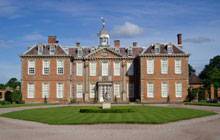 now managed by the National
Trust but originally the seat of Sir George Vernon bart.D.L.,J.P.
Built in 1701 it stands in wooded parkland with a 20 acre garden
and a recreated 18th century crown green bowling green on which
it is possible for visitors to play during normal
opening months which are March to October - for details
of the varying opening hours telephone - 01527 821214.
now managed by the National
Trust but originally the seat of Sir George Vernon bart.D.L.,J.P.
Built in 1701 it stands in wooded parkland with a 20 acre garden
and a recreated 18th century crown green bowling green on which
it is possible for visitors to play during normal
opening months which are March to October - for details
of the varying opening hours telephone - 01527 821214.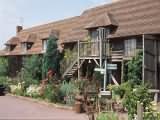
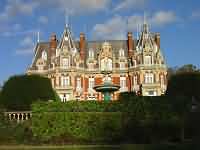 Louis 14th style and spacious gardens
have attracted many visitors including T.V companies, for
many years the nightly Soap - Crossroads used the entrance area
as a set.
Louis 14th style and spacious gardens
have attracted many visitors including T.V companies, for
many years the nightly Soap - Crossroads used the entrance area
as a set.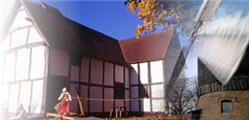 These have been rescued and rebuilt on this picturesque
site, the buildings include a 17th century Cock Pit, a Victorian
Mission church, a Windmill and a 1946 Prefab.
These have been rescued and rebuilt on this picturesque
site, the buildings include a 17th century Cock Pit, a Victorian
Mission church, a Windmill and a 1946 Prefab.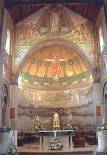 and is only a short journey from the town, to
the rear of the church there is adequate car parking available.
Upon entry into the church it is possible to use the timed lighting
system to enable visitors to see the superb mosaics which cover
the walls and are considered to be superior to any other
than Westminster Cathedral. There are scenes depicting St. Richard receiving
the popes blessing and of the life of our lady, there are a number
of fine sculptures positioned about the church.
and is only a short journey from the town, to
the rear of the church there is adequate car parking available.
Upon entry into the church it is possible to use the timed lighting
system to enable visitors to see the superb mosaics which cover
the walls and are considered to be superior to any other
than Westminster Cathedral. There are scenes depicting St. Richard receiving
the popes blessing and of the life of our lady, there are a number
of fine sculptures positioned about the church.